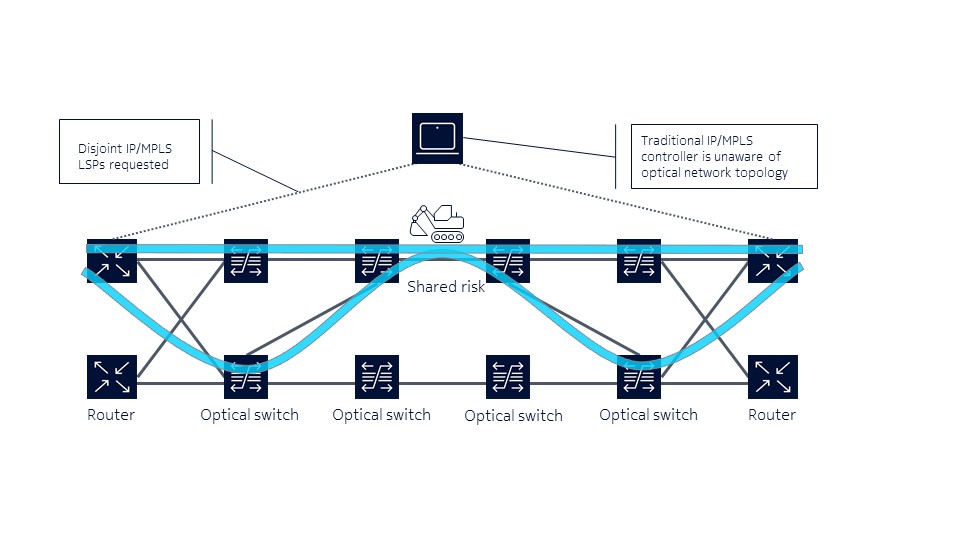SDN in Multi-Layer Networks: Analyze Risk and Reap the Reward

It is sometimes said that there is no reward without risk. However, in IP/optical networking, as in many other fields, the key is to identify and quantify risk. Then any risks deemed significant can be mitigated and contingency plans established. Software Defined Networking (SDN) brings an impressive toolset that can, amongst other things, be used to detect, assess and mitigate risks, so service providers can reap the rewards of an IP/optical multi-layer architecture.
The risks that lie within
In IP/optical networks, understanding the full risk picture in the optical transport can simplify scenario planning and boost network reliability. This can lead to more efficient network operations and better customer retention.
For example, at the IP layer, it may appear that diverse paths, e.g. LSPs (label switched paths), are available between routers. However, deeper insights into the optical infrastructure can reveal shared risks, where two apparently disjoint optical paths traverse a common fiber, duct or optical layer forwarding device. As shown in figure 1, the two apparently diverse paths between the end routers can be vulnerable to a single network-impairing event in the optical layer.

Figure 1: Shared risk in the optical transport layer
No more risky business
Multi-layer networks, under the control of a single jurisdiction, can leverage the advantage of the broad span of control they possess only if accurate tools are available to examine and analyze the real-world physical infrastructure in the separate layers. A centralized, multi-layer SDN controller brings a suite of these required tools that examine, analyze and alleviate risk, and can enable optimal design decisions based on a holistic viewpoint, which is both broad (i.e. multi-domain) and deep (i.e. multi-layer). These tools are ideally suited to analyze risk factors, including incorporating traffic flow and restoration mechanisms into the analysis. The controller is uniquely positioned to ensure that the paths in this example are not subject to similar or shared risks, that is they are fully “shared-risk link group (SRLG)-disjoint” as shown in figure 2.

Figure 2: Fully disjoint paths
While a single multi-layer controller entity is shown in the figure above for simplicity’s sake, in practice, the multi-layer controller will be communicating with, and orchestrating the activities of, other SDN controllers (e.g. for the IP/MPLS and optical layers.)
Multi-layer SDN takes on the bigger risk list
Inventory versus reality risk
Discovering, capturing and accurately visualizing the complete topology and interconnection points of the network, from layer 0 to 3, can be a significant challenge to operators. Organic growth over time, often driven by separate organizations, can lead to excessively complex, poorly understood network architectures. These bring the potential for severe operational issues such as unpredictable failure impacts on crucial network traffic and sub-optimal latency control. A multi-layer SDN management architecture can bring a coherent and unified view to the management of IP/optical networks which enables clear insight into the way in which traffic is engineered onto network paths. This permits comprehensive route computation to take place with the goal of using the available network resources in the best way to achieve maximum efficiency.
Maintenance coordination risk
Network maintenance is a vital, but potentially risky, activity. For example, maintenance work may have to be carried out on optical infrastructure components while the network continues to meet its performance goals.
An automated multi-layer maintenance procedure is needed to minimize negative impacts to user traffic during maintenance activities. Carrier SDN visualization can be used to ensure minimal impact to IP Services during planned maintenance activities. These activities at the IP and optical layers can be coordinated and orchestrated, for example, to keep IP traffic away from affected optical links during the actual maintenance.
Non-optimal protection risk
In IP/optical networks, the full set of risk scenarios in the optical transport layers (0/1) must be discovered to simplify scenario planning and boost network reliability. A multi-layer protection strategy must be devised so that traffic is protected at the most cost-effective layer without the need for expensive 1:1 redundancy, and avoiding inefficient double protection scenarios.
Seeing clearly with multi-layer SDN
SDN can bring many advantages to the operation of carrier networks across a range of automation and optimization functions. Multi-layer SDN controllers, due to their broad and deep perspective on the network are well positioned to seek out, assess and mitigate risk leading to less network and service outages, more efficient resource usage, and deeper insight into, and control of, the network and services.
Learn more about multi-layer SDN.
 About the Author: John Davies, senior marketing manager at Nokia, is primarily engaged in identifying and communicating use cases and value propositions in software defined networking, with a focus on multi-layer and optical applications. John has held a number of design, development, product management and marketing roles during his 30+ years in the telecommunications industry. He holds a degree in Engineering from The University of Wales, Institute of Technology.
About the Author: John Davies, senior marketing manager at Nokia, is primarily engaged in identifying and communicating use cases and value propositions in software defined networking, with a focus on multi-layer and optical applications. John has held a number of design, development, product management and marketing roles during his 30+ years in the telecommunications industry. He holds a degree in Engineering from The University of Wales, Institute of Technology.
Edited by Mandi Nowitz

